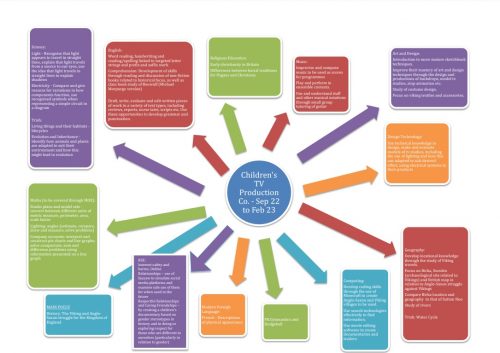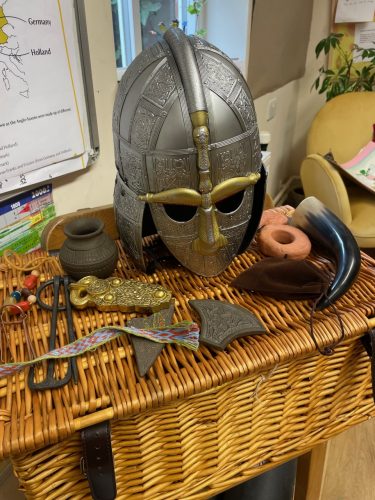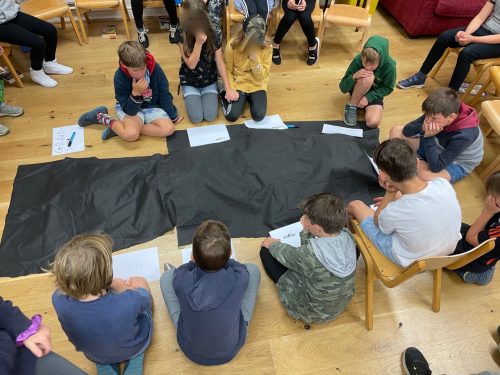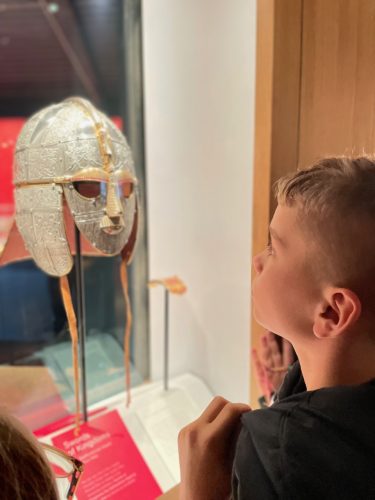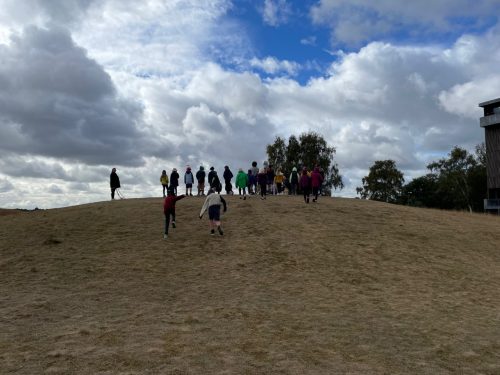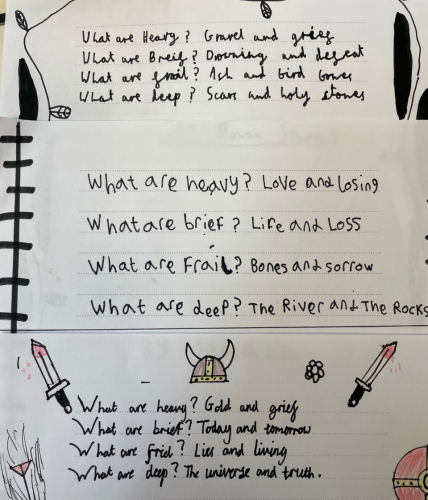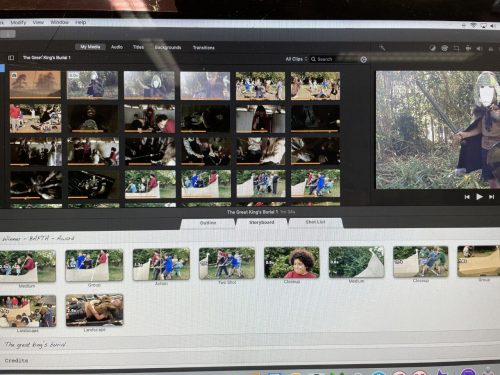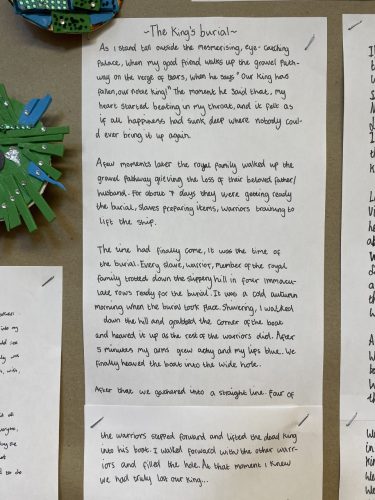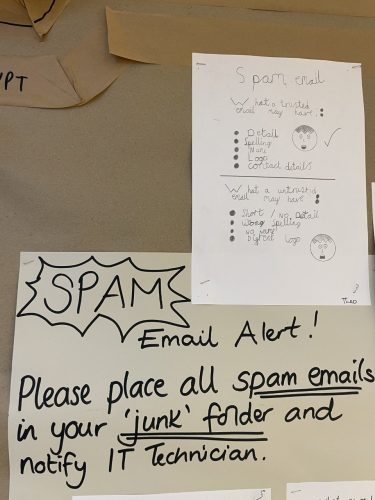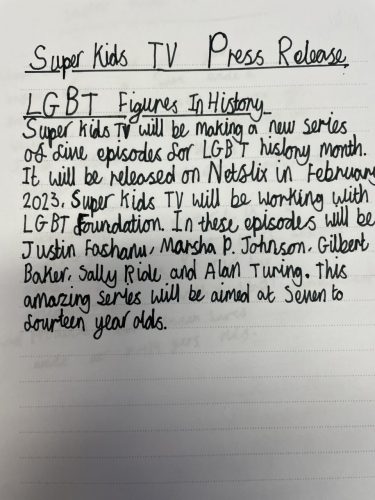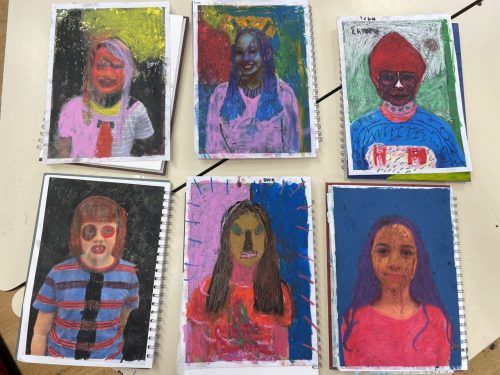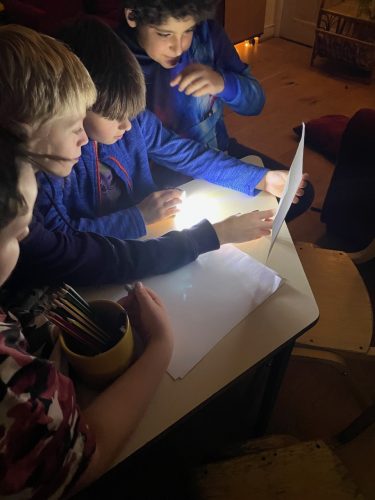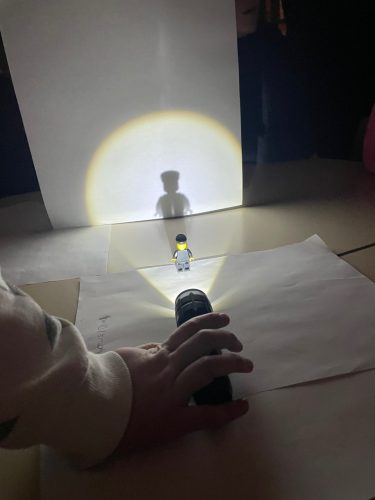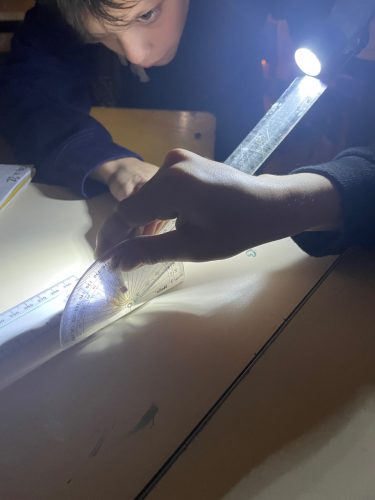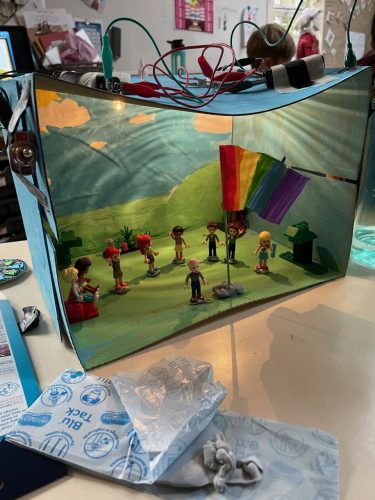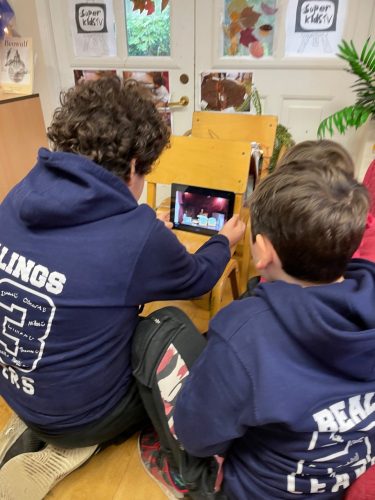w/c 5th September
Last term, several of the Year 5s had commented on their disdain for Horrible Histories as an historical programme for children. With reference to this, the children were asked to write a review of an episode about Alfred the Great. We examined the features of film reviews by reading real reviews from films we’ve enjoyed (or not) in the past, before watching the episode and making notes based on our likes and dislikes of the programme.
After watching the episode, we shared our opinions and then ordered the noted film review features to give us a plan for writing our own. We also looked at synonyms for words we might want to use a lot (great and bad) and recorded these to be used in our writing.
We then wrote first drafts of our reviews before editing and redrafting later in the week.
Examining the dislikes list that we had created about Horrible Histories, we came up with an alternative list that noted what a good children’s tv production company should ensure when creating programmes. Instead of offensive material, the children stated that the company should be respectful and truthful, as well as creating content that was informative and trustworthy.
This list then became a list of our own company values as we quickly realised we would be running a children’s tv production company this term. We then went on to choose a name (Super Kids TV) and design a logo.
w/c 12th September
As Super Kids Tv we began to think about the technology and equipment we would use on a regular basis. These formed part of the landscape of our work and were placed on the walls in the room as a nod to our daily work as a company. ID badges were created to increase the sense of belonging.
We looked at the history of television by sorting a mixed timeline of the history of the BBC. We talked about how children’s television had changed over the years and linked this to our parents and grandparents (who were also asked to share their memories at home with the children).
Getting to the work itself, we received a letter from the iPlayer team at the BBC referring to a children’s historical documentary series we made in the past about royal burials in history. They are re-launching it on the platform and want us to make a trailer, specifically featuring the excellent episode about the famous Anglo-Saxon ship burial.
Unfamiliar words in the letter were discussed to ensure understanding (indefinitely, ceremonial, re-enactment) and with several words beginning with re- we talked about this prefix and its meaning.
Many of us had questions about the letter; we were unsure as to what famous Anglo-Saxon burial they were referring to. We needed more information.
Having borrowed a loan box of artefacts from Sutton Hoo, the items were revealed as props from the episode. We used our historical enquiry skills to decide on what they were and use the items as clues to who this burial may have been for – clearly a wealthy and important person, probably a male (due to the warrior items included – though this remained a question – could we just assume based on this stereotype?).
The final reveal was the helmet itself. This was very familiar to the children who had seen it on logos for their rugby teams and so forth. Most knew him as the Woodbridge Warrior. Some knew him to be the King buried at Sutton Hoo.
w/c 20th September
The children walked into the room to see a ‘body’ lain out on the floor and covered with a black sheet. We assumed this to be the dead King and found ourselves back in 625 AD (helped by the date given to the burial provided by coins). Gradually, we built up a picture of the grieving family around the body (wife, sons, grandchildren). The child in role as the Queen had been told to fight for a pagan burial. The son, and future King, was told to fight for a Christian one. In role as the family and advisers, the children debated what kind of burial he should have.
We heard how a monk had written that despite King Raedwald having been Christened during his reign, his wife had persuaded him to return to his pagan beliefs. From the son’s point of view, we knew that when he became King East Anglia would convert to Christianity. Understanding these views, we could consider the reasoning for both preferences.
Unable to come to an agreement, the children chose a side and wrote a persuasive letter to either the Queen or future King. In the end, the Queen enforced a pagan burial and allowed a few Christian items to be placed inside the tomb.
Now it came to planning how to move the great ship from the Deben up to the Hoo. Looking at the measurements of the ship we went out onto the playground to estimate and measure the size of the ship. We were amazed by its size. This then led to several weeks work bases around perimeter, area and volume of the boat and other shapes.
w/c 26th September
On Tuesday we visited Sutton Hoo to find out more about the burial.
On returning to school, we looked more at the role of the warriors moving the ship. In role as the warriors the children presented their reasoning for being given the great honour of moving the ship. Aware that great warriors recited poetry, told stories and sang songs, the children were presented with two poems from which to choose (What are Heavy? by Christina Rosetti and The Eagle, by Lord Tennyson). The children took them home to learn them and returned the next day to stand before their Queen and recite their poem.
We then drew designs of our ideas of how to best move the ship. We recreated Sutton Hoo using mud and rocks from the field, then studied the contour lines on an Ordnance Survey Map in order to work out how high above sea level the Hoo is/was.
Focusing on the What are Heavy? poem, we began to write our own versions, playing with words and creating many different versions. Then we began this term’s class book, the great Anglo-Saxon/Viking poem, Beowulf (but the Michael Morpurgo version).
w/c 3rd October
Returning to our company, we chose a trailer template which most suited our episode about the Sutton Hoo burial. We began to carefully select the language to be used in it, and having agreed together a rough outline of the trailer, formed groups to design the shots for each section. Actors were chosen for the roles within the episode.
In the meantime, the children used natural and DT resources to create a representation of the ideas for how to move the ship up the hill. Force work from Year 3/4 was recapped when discussing pushing, pulling and friction.
We returned to the What are Heavy? poems and created a final version, suitable for the burial.
w/c 10th and 17th October
(weeks combined due to teacher absence with covid)
With the layout of the trailer complete, we prepared props and filmed the shots needed. The children used an iPad to film each segment and together we used iMovie to drag the shots into the trailer layout and completed the text to be included.
Our trailer was complete and ready to be used by iPlayer to advertise our series.
Finally, we wrote stories about the burial from a chosen point of view (the Queen, a warrior, or even the King himself).
HALF TERM
w/c 31st October
A letter arrived from the LGBT Foundation, inviting us to create a series for LGBT History Month to be shown on Netflix in February. This would be to feature LGBT figures in history and should be aimed at 7-14 year-olds.
Many of us were unsure about what LGBT stood for, so we looked at each letter and considered the definition of each term.
As we had never heard of the LGBT Foundation, some of the children wondered if it was a letter from someone we could trust, or instead, a fake. We considered the ways in which we could judge whether a letter could be trusted and with a strong website and contact details, we were able to arrange a meeting with the sender, Madelaine (teacher in role).
This consideration also led us to check our emails. It looks like we’ve been sent some spam emails lately and we looked carefully at our emails to share what to look out for when deciding if an email is trusted or not. Information texts (using colons and bullet points) were created to inform employees of the dos and don’ts regarding emails.
Having met Madelaine and had all our questions answered, we were satisfied to take on the job. She suggested a list of possible people to be featured and sent this information to us.
w/c 7th November
Carefully we read the bullet point information about the possible characters to be featured in our series. We discussed the pros and cons of each, thinking carefully about the age of our audience. Finally, we agreed the 5 people to featured: Gilbert Baker (designer of the rainbow flag), Alan Turing (WW2 code cracker), Sally Ride (American astronaut), Marsha P. Johnson (transgender rights activist) and Justin Fashanu (first black footballer to achieve £1 million transfer fee).
Having decided on our series we wrote press releases to inform the press of what was to come.
Separately from our MOE work, visiting artist, Kate Stephens, began to look at LGBT artists, starting with Andy Warhol. The children worked over photos of themselves to create new identities.
We also looked at the UN Declaration of Human Rights (article 1) as well as how these are linked to British Values.
w/c 14th November
Having decided on our featured individuals we read information about each character. Stop Animation was chosen as the way in which we were to create our episodes, so we formed groups to consider how we would create this. Story boards were created, dioramas for the sets were made and scripts for each episode were written.
Keith Haring’s art was also studied and used to inspire our own pieces.
w/c 21st November
In order to create the lighting for our sets we used electrical components to form a circuit with an on/off switch. We noticed what happened if we added more bulbs to the circuit and investigated how to make the bulbs grow brighter. Some of us chose to use buzzers and a few extended their learning by creating a moving vehicle for their scenes, using the motors. We drew diagrams of some of the circuits we had created.
With the lights working we examined the impact of shadows. We investigated how shadows changed when we moved the light source closer or further away to the object. Our results were not all the same and when we examined this closer, we realised that the answers were different depending on whether we were looking at shadows on the wall or on the floor, as well as the positioning of the light in relation to the ground. If we all looked at shadows on a wall, all of our results were the same (the closer the light source the larger the shadow).
w/c 28th November
This week we looked into the impact of different angled light sources. We planned a fair test by strapping the torches to a ruler – ensuring the light source always remained the same distance from the object. We then used protractors to measure the angle of the light source and recorded the measurements of the shadow at every 10 degrees. We found that the greater the angle of the light source from the ground, the shorter the shadow. This investigation was then written up as a piece of scientific writing.
This work on shadows led us to look at how they are formed and the shape of light rays. Continuing our investigations, we used mirrors to create light/reflection journeys around the room. We used our technical drawings of these light journeys to measure and find missing angles on a straight line (the mirrors being the straight line).
Circuits including light bulbs were created and added to our dioramas. We were then able to start work on our Stop Animations – shooting 6 photos per second. We used our scripts to track our scenes and to help us to consider the length of each scene needed.
w/c 5th December
As each different group had slightly different measurements in our most recent science investigation, we shared our results to create a class table. We then used the data to create the mean, mode, median and range. This enabled us to look for patterns in our results as a whole.
Our Stop Animations were finished this week and we used iMovie to edit them into short films, adding dialogue, music and sound effects.
This week we were visited by Madelaine Temper (teacher in role) from the LGBT Foundation. She was sad to report that since the press release, they had had serious threats and complaints from many parents who felt that the series we were producing was not appropriate for children. Madelaine hoped that this would not put us off, but warned that there could be serious unrest with a social media hate campaign growing. We examined key terms she had used (hate speech, homophobia, parental voice, social media campaign etc.).
As a company we discussed how we felt about this and we tried to see it from the point of view of these parents, looking for reasons why they might feel that way (upbringing, not understanding, religion etc). But then we went into role as one of the historical LGBT figures we were representing in our series and put ourselves in their shoes, hearing how these parents felt that people like them were ‘inappropriate’ for children to learn about. This gave us a real understanding of what it is like to be in that community and hear such negative words.
Some had initially suggested putting an older age rating on our series so that it wouldn’t appear on the children’s platform, but after our drama and much debate it was agreed that it was not right for these parents to try to ban their children from learning about people from the LGBT community, being a world where everyone is different and everyone should be treated the same.
So it was decided, we would continue and face the negative attention and criticism if it were to come.
w/c 9th January
An advert has appeared detailing Channel 4s desire to create some new children’s content. They are looking for interested tv production companies to help. We speak to the Head of Children’s Content at C4 who asks us to create a short reel of our company history, including the work we have done.
Using drama we create moments from our company history, these are filmed and uploaded to the class iMac in order to be used on iMovie. We write narrations for the history and begin to think about a music composition to go over the short film.
Using percussion instruments, we explore pulse, rhythm and melody, as well as musical notation. We create short group compositions of four bars. An official soundscape for our film will be worked on, composed and completed within the coming weeks.
w/c 16th January
With time in the half term already escaping us, we travel forward in time in our mantle, to hear that we have successfully secured a job with Channel 4. The Head of Children’s Content wants us to produce a historical fiction drama about Viking invasion.
Knowing that we are about to go into role as monks, the children are provided with an information text to read about anglo-saxon monks and monasteries. This is discussed by the class as we read it.
We then begin our drama by finding ourselves in role as monks at Iken, being told about a terrible attack on a monastery in the kingdom of Northumbria. Words are used such as ‘North Men’, and ‘Heathens’, as well as reference to St Cuthberts. The children in role, join in prayers asking for protection from God against any attacks that may come their way.
This drama obviously provokes questions and some children think that the attack of the North Men many be a reference to Viking attacks. In order to form a baseline assessment of what we think we know about the Vikings the children are asked to note down their current knowledge in their books. There are many preconceptions and so the ideas are written up on the wall to be addressed as our learning uncovers.
The children are then tasked to order a timeline of events detailing the spread of Christianity in Anglo-Saxon Britain. This links to our earlier work on King Redwaeld, as well as mentioning St Cuthbert and Lindisfarne. The timeline explains how a monastery at Lindisfarne was created, as well as St Cuthbert’s link to it, and ends with the Viking attack on Lindisfarne of 793CE.
Longitude and Lattitude co-ordinates are used to locate the position of Iken and Lindisfarne using maps. We then use an ordnance survey map to discuss where we think the Monsatery at Iken may have been located. We also came up with ideas about where a neighbouring settlement might have been, taking into consideration the position of the river as well as the height of the land.
We read about the daily lives of Anglo-Saxons and note the jobs that were prevalent, as well as picking up new vocabulary such as Thanes, Churls and hides.
Back in role, we discuss whether we should pass on the news of these North Men attacks to the local people. We don’t want to frighten them after all, but little do we know, someone is already listening.
